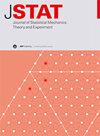作为随机点过程的不同猎鸟之间的相互作用
IF 1.9
3区 物理与天体物理
Q2 MECHANICS
Journal of Statistical Mechanics: Theory and Experiment
Pub Date : 2024-05-15
DOI:10.1088/1742-5468/ad37be
引用次数: 0
摘要
二维(2D)库仑气体是随机点过程的单参数族,取决于反温度β。基于先前的工作,我们提出了库仑气体作为一种简单的统计量度,用于量化三种不同的高领地性猛禽之间的种内和种间排斥。我们利用 Teutoburger Wald 地区 20 年来的数据,将苍鹰、鹰鸮和之前研究过的普通鵟各自巢穴之间的近邻和近邻间距分布拟合为库仑气体的 β。在每个物种内部,用这种方法测得的斥力都明显偏离了平面上独立点的泊松过程。相比之下,我们发现两个物种之间的斥力要小得多,更接近泊松过程。在方法上,我们研究了地形的影响、二维汤川相互作用给出的较短的相互作用范围,以及我们用于每年被占巢穴集合的时间移动平均数的统计独立性。我们还检验了平均水平间距数量级的原始巢穴位置的人为随机位移会迅速破坏β > 0所测量的排斥力。事实证明,从非赫米提随机矩阵理论推导出的近邻间距分布的简单近似分析表达式非常有用。本文章由计算机程序翻译,如有差异,请以英文原文为准。
Interactions between different birds of prey as a random point process
The two-dimensional (2D) Coulomb gas is a one-parameter family of random point processes, depending on the inverse temperature β. Based on previous work, it is proposed as a simple statistical measure to quantify the intra- and interspecies repulsion among three different highly territorial birds of prey. Using data from the area of the Teutoburger Wald over 20 years, we fit the nearest-neighbour and next-to-nearest neighbour spacing distributions between the respective nests of the goshawk, eagle owl and the previously examined common buzzard to β of the Coulomb gas. Within each species, the repulsion measured in this way deviates significantly from the Poisson process of independent points in the plane. In contrast, the repulsion amongst each of two species is found to be considerably lower and closer to Poisson. Methodologically, we investigate the influence of the terrain, of a shorter interaction range given by the 2D Yukawa interaction, and the statistical independence of the time moving average we use for the yearly ensembles of occupied nests. We also check that an artificial random displacement of the original nest positions of the order of the mean level spacing quickly destroys the repulsion measured by β > 0. A simple, approximate analytical expression for the nearest-neighbour spacing distribution derived from non-Hermitian random matrix theory proves to be very useful.
求助全文
通过发布文献求助,成功后即可免费获取论文全文。
去求助
来源期刊
CiteScore
4.50
自引率
12.50%
发文量
210
审稿时长
1.0 months
期刊介绍:
JSTAT is targeted to a broad community interested in different aspects of statistical physics, which are roughly defined by the fields represented in the conferences called ''Statistical Physics''. Submissions from experimentalists working on all the topics which have some ''connection to statistical physics are also strongly encouraged.
The journal covers different topics which correspond to the following keyword sections.
1. Quantum statistical physics, condensed matter, integrable systems
Scientific Directors: Eduardo Fradkin and Giuseppe Mussardo
2. Classical statistical mechanics, equilibrium and non-equilibrium
Scientific Directors: David Mukamel, Matteo Marsili and Giuseppe Mussardo
3. Disordered systems, classical and quantum
Scientific Directors: Eduardo Fradkin and Riccardo Zecchina
4. Interdisciplinary statistical mechanics
Scientific Directors: Matteo Marsili and Riccardo Zecchina
5. Biological modelling and information
Scientific Directors: Matteo Marsili, William Bialek and Riccardo Zecchina

 求助内容:
求助内容: 应助结果提醒方式:
应助结果提醒方式:


